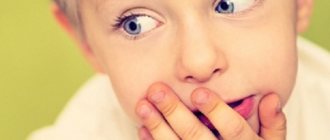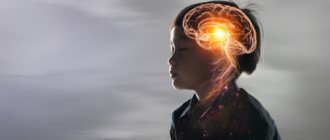Dysphasia is a persistent underdevelopment or complete absence of speech caused by organic lesions of the cortical areas of the brain responsible for speech development. Unlike aphasia, in which there is a loss of already formed speech (due to injury, vascular diseases of the brain, tumors, brain surgery, etc.), dysphasia begins to develop in the prenatal period or at the early pre-speech stage of the child’s development. The severity of the disease depends on the time at which the brain damage occurred; the most dangerous period is 3-4 months of pregnancy. In the Russian classification of diseases, this disease is called alalia (not to be confused with dyslalia - a distortion of speech, sound pronunciation, which is not considered a gross violation of speech development up to 5 years), and in various sources you can find the names: “developmental dysphasia” or “early childhood aphasia.”
What is developmental dysphasia?
Dysphasia is understood as persistent underdevelopment or complete absence of speech in a child. This pathology is associated with certain organic lesions in the cerebral cortex, which is responsible for the development of speech skills. Dysphasia is often confused with aphasia, in which the child stops speaking due to loss of speech skills. This happens as a result of severe injuries resulting in concussion, vascular diseases or surgery on the cerebral cortex, as well as its tumors.
Dysphasia always begins to manifest itself in the perinatal or early period of development of the infant's speech skills. The severity of the disease when visiting a doctor is determined based on the time of damage to the brain systems. The most dangerous periods are considered to be 3–4 months of pregnancy. A child with this disease not only cannot speak, but also often poorly understands the speech of the people around him.
REFERENCE! Dysphasia in the Russian classification of diseases is called alalia. This term should not be confused with the common disease dyslalia, in which the child has speech, but is severely distorted. Various sources also give the same type of name for dysphasia - this is “early childhood dysphasia” or “developmental dysphasia”.
The field of neuroscience that studies the basis of behavioral and cognitive disorders can be referred to as behavioral neuroscience.
In child behavioral neurology, this connection is considered not only from a clinical point of view, but also from a developmental perspective, which is especially important in relation to children with difficulties in communication, learning, behavior, speech disorders, motor skills, and praxis. Among these disorders, a significant place is occupied by speech underdevelopment, which occurs with a frequency of up to 5-10% under the age of 6 years [5]. Many of these children are not able to fully master the school curriculum and experience significant difficulties in social adaptation.
Among speech development disorders in young children, L.O. Badalyan [1] distinguished partial (impaired formation of sound pronunciation) and general (delayed speech development - developmental dysphasia, or alalia). According to modern international classifications, “dysphasia” or “developmental dysphasia” is a systemic underdevelopment of speech as a result of damage to the cortical speech zones in the pre-speech period. Among the leading causes of speech development disorders, damage to the central nervous system during the periods of pre- and perinatal development is considered.
In cases of speech development disorders, hereditary predisposition plays an important role, which is confirmed by the high frequency of such disorders in the families of patients [5]. Among the genes that can determine delayed speech development, FOXP2
on chromosome 7q31.
It is believed that FOXP2
simultaneously controls both the acquisition and application of grammatical language rules and speech motor skills - movements of the muscles of the tongue, lips, and larynx.
There are familial and sporadic cases of expressive language disorders caused by mutations in the FOXP2
[10].
Protein encoded by FOXP2
, controls the transcription process and controls the activity of other genes.
FOXP2
influences the formation of neuronal processes and synapse density.
His work is not limited in time to the prenatal period; he continues to determine synaptic plasticity in the future, including in adulthood. Apparently, the functions of the FOXP2
relate not only to the formation of expressive speech, but also include coordination of the cascade of genes and proteins necessary for the development of brain functions, including the regulation of fine motor control [10].
FOXP2
belongs to the large
FOX
, including more than 40 genes.
Other genes in this group are also considered candidates for speech disorders. Among them is the FOXP1
on chromosome 3p14.
Modern studies indicate that the protein product FOXP1
may be involved in the modification of motor neurons, neuronal migration through regulation (restriction) at the level of relin signaling pathways, and neuronal differentiation [10].
Thus, FOXP1
, like its “partner”
FOXP2
, may be responsible for the formation of complexes of brain structures that are important for speech development.
Among the genes that FOXP2
CNTNAP2,
located in the 7q36 locus , a gene encoding a transmembrane contactin-associated protein.
The gene covers 1.5% of chromosome 7 and is one of the largest in the human genome. Existing research in this area [12] suggests that CNTNAP2
plays a role in susceptibility to complex forms of language impairment (expressive and impressive language, phonological short-term memory).
CNTNAP2
plays a key role in neuroontogenesis, mainly during the formation of the frontal lobe of the brain. The CASPR protein it encodes is responsible for the distribution of potassium channels in developing neurons and ensures the activation of axonal-glial interactions. During the formation of brain structures, it is localized in those parts of the brain that develop at a faster rate, i.e. areas responsible for learning and development of speech, as well as thinking.
An association of speech development disorders was also found with two genes on chromosome 16: ATP2C2
in 16q24 and
CMIP
in 16q24. Changes in both genes were predominantly associated with the results of the phonological short-term memory test, which confirms the importance of memory processes in speech acquisition [9]. Thus, the last decade marked the beginning of the study of the molecular genetic basis of speech disorders. Specific genes responsible for the brain mechanisms of speech formation have been discovered and studied.
Developments in the field of the disorders under consideration are also actively developing.
The purpose of this study is to study the neurological, neuropsychic status and speech in children with developmental dysphasia during treatment with Cerebrolysin.
Material and methods
We examined 60 children aged from 3 years to 4 years 11 months with developmental dysphasia - a disorder of the development of expressive speech (category F80.1 according to ICD-10 [7]) and a picture of general underdevelopment of speech of the 1st-2nd level according to the domestic psychological and pedagogical classification [6].
The children were referred to a neurologist after a speech therapy examination, who monitored them on an outpatient basis.
Patients whose speech development delay was caused by hearing loss, mental retardation, autism, severe somatic pathology, malnutrition, as well as the influence of unfavorable social factors (insufficient communication and education) were excluded from the study group.
During an open controlled study, patients with developmental dysphasia were divided into 2 groups: 1st group, main group - 30 children (23 boys, 7 girls) who were treated with Cerebrolysin; Group 2 (control) - 30 children (23 boys, 7 girls) did not receive drug therapy. The children were observed for 2 months.
Cerebrolysin was prescribed as monotherapy, at an average daily dose of 0.1 ml/kg body weight (from 1.5 to 2.5 ml), in the morning, every other day, intramuscularly (30 injections per course). To reduce the likelihood of side effects at the beginning of the course, it was recommended to gradually increase the dose of Cerebrolysin over 6-10 days. The examination was carried out before the start of treatment (day 0) and at the end of it (day 60). All children were consulted by a speech therapist and their parents were provided with recommendations aimed at stimulating speech development. During the observation period, specialists assessed the vocabulary and state of children’s phrasal speech. For this purpose, parents were asked to keep an observation diary in which all new words and phrases that the child began to pronounce were noted, indicating the dates of their appearance. At the same time, the state of children's speech was assessed in comparison with age characteristics using a 10-point system. In this case, scales were used aimed at assessing speech perception (impressive speech), speech attention and spoken (expressive) speech [3].
Parents were also surveyed using a structured questionnaire [4]. It provided answers to a list of questions on 63 symptoms grouped into 10 scales: cerebrasthenic symptoms, psychosomatic disorders, anxiety, motor clumsiness, hyperactivity, speech disorders, attention deficit, emotional disturbances, behavioral problems, aggressiveness and oppositional reactions. Rating of answers: symptom absent - 0 points, slightly expressed - 1 point, significantly - 2 points, very strong - 3 points.
When studying the motor sphere, the quality of performance of age-appropriate tasks was assessed in points [4] using a test for walking along a line and a task for maintaining balance.
Statistical analysis of the results was carried out using the nonparametric Wilcoxon test.
results
The dynamics of indicators of expressive speech in children with dysphasia over a 2-month observation period are presented in Table. 1 and 2
.
They show that the initial characteristics of expressive speech (vocabulary and phrases) in the two groups of patients were close. After treatment with Cerebrolysin, in the main group, in contrast to the control group, there was a significant improvement. The volume of the active vocabulary increased by 3.5 times, the number of spoken phrases - by 5 times, while in the control group they increased only by 1.5 times. Almost all indicators of expressive speech were characterized by highly significant positive changes ( p
<0.001), including in relation to the number of words spoken, the average and maximum number of syllables in spoken words, the number of phrases in spoken speech, and the average and maximum number of words in phrases.
When assessed using speech development scales, initially both groups of children with dysphasia had the lowest expressive speech scores (see Table 2)
.
p
was achieved not only on the expressive speech scale, but also on the impressive speech and verbal attention scales. For children in the control group, scores on these scales did not change significantly over the same period.
Results of the parent survey (Table 3)
showed that during treatment with Cerebrolysin, children with developmental dysphasia experienced a significant decrease in the severity of cerebrasthenic phenomena, psychosomatic disorders, motor awkwardness and fine motor difficulties, as well as manifestations of hyperactivity, attention deficit, difficulties in emotional control and behavior.
Compared to this, in the control group there was a slight decrease in psychosomatic disorders, motor awkwardness and difficulties in emotional control, which could reflect the natural age-related dynamics of the formation of the corresponding functions of the nervous system during the observation period.
The development of speech and the formation of coordination of movements and manipulative activities of the hands occur in parallel to each other. Many children with developmental dysphasia lag behind their peers in motor development and are clumsy, clumsy, and have poor coordination of movements. Therefore, overcoming delays in motor development is an important element of the therapeutic program for dysphasia. The results of the study of the motor sphere with a score for completing tasks for walking along a line and maintaining balance are presented in the figure.
.
Figure 1. Results of a study of the motor sphere in dynamics in groups with developmental dysphasia. Significance of differences between groups: * - p
<0.001.
The data obtained coincide with the results of a parent survey and indicate a positive effect of Cerebrolysin on the motor sphere of children with developmental dysphasia. Points in this method were awarded for errors and difficulties in completing tasks, while during therapy with Cerebrolysin, the total score decreased from 4.1±0.2 to 2.4±0.1 ( p
<0.001), which is an objective confirmation of its favorable influence on the motor sphere and the formation of motor skills.
Side effects of Cerebrolysin occurred in 3 patients and were expressed in the form of difficulty falling asleep in the 1st week of therapy. These phenomena were minor, self-limited and did not require temporary discontinuation or dose reduction of the drug.
Discussion
It is known that the possibilities of mental development of children with dysphasia, the success of their schooling and social adaptation depend on the early detection and correction of speech disorders. It is necessary to take into account that disorders of speech formation can be not only consequences of perinatal brain pathology, but also have genetic prerequisites. It is neurobiological factors that play the main role in the occurrence of damage or insufficient development of the speech centers of the cerebral cortex, disturbances in the formation of connections between them and other brain structures.
The results obtained in this work allow us to conclude that Cerebrolysin has a pronounced positive effect on the state of speech, indicators of motor skills and behavior in children 3-4 years old with developmental dysphasia and general underdevelopment of speech of the 1st-2nd level. This may be due to the fact that Cerebrolysin contains amino acids and low molecular weight biologically active neuropeptides, which, when administered peripherally, are able to penetrate the blood-brain barrier and have a multimodal effect on brain cells. The drug has proven neurotrophic activity, similar to the action of natural neurotrophic factors [2, 11]. The concept of the activating effect of Cerebrolysin on the processes of neurogenesis and the mechanisms of neuroplasticity is increasingly being confirmed [8, 13], taking into account which its pronounced effect in developmental dysphasia in children can be explained.
The therapeutic effect of Cerebrolysin in the treatment of developmental dysphasia in children was characterized by a significant improvement in indicators of expressive and impressive speech, as well as speech attention. The volume of active vocabulary in the main group increased by 3.5 times, the number of spoken phrases - by 5 times, while in the control group - only one and a half times. As a survey of parents showed, children showed a decrease in cerebrasthenic and psychosomatic disorders, motor clumsiness, hyperactivity, and improved attention, emotional control and behavioral characteristics.
Cerebrolysin has also been shown to have a positive effect on the motor sphere, as well as the formation of motor skills. The positive side of the action of Cerebrolysin is also the low frequency and insignificant severity of the side effects it causes.
Let us emphasize once again that speech for a child is the most important means of communication with the outside world, an opportunity for interaction, a source of information and the development of thinking. Developmental dysphasia is a common and severe disorder of speech development at the stage when speech is already present, but the ability to speak is significantly impaired; At the same time, speech understanding may vary, but is much better developed. At the same time, most children with dysphasia experience delays in motor development and difficulties in emotional control and behavior. Therefore, when organizing assistance, the complexity of the impact and continuity of work with children by specialists of various profiles acquire special importance. Speech therapy, psychological, pedagogical and medical correctional measures should be carried out systematically and over a long period of time.
The sooner problems in a child’s speech development are identified and comprehensive assistance begins to be provided, the better the results will be. The most effective treatment is considered to be carried out during the sensitive age period for speech formation, from 2.5 to 5 years, when the active development of speech function is underway and the reserve capabilities of the child’s brain are especially significant. A promising direction for further research is to study the role of neurotrophic factors in the pathogenesis of speech development disorders and their treatment.
Types of dysphasia
There are several types of dysphasia:
- Motor. With this disease, changes occur in the cerebral cortex, leading to the inability to express one’s thoughts in words. In severe forms, children are not able to begin to speak, but can only make individual, inarticulate sounds. At the same time, they retain the ability to express their emotions and feelings through gestures and intonation. Many children with diagnosed motor dysphasia can speak up to 7 years of age, but they have incorrect speech production, confusion in expressing feelings, and confusion in words. Difficulties in oral speech are usually accompanied by problems in reading and writing letters. A sick child’s mental images are formed clearly, but he is unable to express them in language or in writing.
- Sensory. A sick baby has difficulty understanding someone else’s speech and does not fully understand the meaning of individual words and phrases. The process of perception is similar to that of a foreigner speaking to him. Information can be conveyed to a child only in fragments of individual phrases consisting of no more than 2-3 words. At the same time, the calmer and more monotonous the voice, the greater the chances of learning the meaning of what was said. Along with the difficulty of perceiving and understanding speech information, the child experiences forgetfulness. He is not able to read the text legibly, even if he wrote it himself.
- Sensorimotor. Speech impairment affects motor and sensory impairments. Children with this diagnosis are unable to understand words and expressions or express their emotions in clear speech. Pathology does not allow verbal and nonverbal communication skills to fully develop.
Symptoms
The symptoms of childhood dysphasia vary and depend on the age and personality of the individual. The first signs of the disease are the fact that it is difficult for the baby to express his thoughts; he takes a long time to find the right words to express an emotion or desire.
Speech is slow, drawn-out and abrupt at the same time. The child is not able to speak a long monologue. To pronounce a single phrase of 3–5 words, it takes him almost half a minute. It is difficult to grasp the meaning of a child’s monologue.
ATTENTION! A characteristic sign of motor dysphasia is the omission of short words and prepositions. His speech contains unnecessary sounds and meaningless phrases. In writing, a sick child makes a lot of grammatical errors in elementary words, not to mention punctuation marks. At the same time, the order of words can change randomly.
In terms of perception of speech and emotions of other people, the child experiences the following symptoms:
- tries in vain to perceive the meaning of the words, while making a corresponding grimace;
- sometimes it seems that the baby understood what was said, but in the end he simply distances himself from the incomprehensible information and goes deep into himself;
- Before answering something, he thinks for a very long time, and when asked, he slowly fulfills it;
- may inadvertently respond sharply to a simple request;
- does not perceive fast speech at all, and even more does not like active gestures at the same time;
- Grammar is very difficult, mistakes in writing are inevitable.
At an early stage of manifestation in an infant, symptoms of the disease appear in the form of incoherent babbling and a lack of habit of imitating sounds pronounced from the outside. This behavior is usually observed in the first or second year of life. After 2.5 years, development slows down. The vocabulary is not replenished and, as a result, becomes poorer. After three years, such a child cannot be taught to generalize words into phrases and distinguish between concepts such as synonyms and antonyms.
Causes
The reasons for the development of motor dysplasia are:
- Factors affecting the fetus in a pregnant woman. Frequent ionizing radiation, such as X-rays, can negatively affect the proper formation of the baby's brain. If the mother drank alcohol during pregnancy or was exposed to household toxins or drugs, then the likelihood of pathology increases. If the expectant mother has infectious diseases such as syphilis, rubella, toxoplasmosis or cytomegalovirus infection, the development of the fetus is disrupted.
- Injury to a child's brain as a result of childbirth. For example, suffocation, squeezing the baby’s head with obstetric forceps and, as a result, intracranial hemorrhage.
- Lack of iodine in a child’s diet at an early age (in the womb and at the growth stage up to 2–3 years).
- Autism.
IMPORTANT! Vascular lesions of the brain as a result of injuries can occur due to problems with adequate blood supply. Injury can be open or closed. All of them lead to disruption of speech centers. The area of brain damage in motor dysphasia is extensive and can only be treated with long-term treatment.
Treatment
As a therapy, a child with motor dysphasia must be observed by a speech therapist. Special techniques will help the baby form and develop speech, establish the correct pronunciation of individual syllables and phrases. In addition, the baby is prescribed nootropic drugs that improve the nutrition of brain cells.
A mandatory stage of treatment is the development of speech and related skills. Specially selected algorithms will help compensate for existing violations. In primary and secondary schools, children diagnosed with motor dysphasia receive tutoring. Such children also need the help of a psychologist, psychotherapist and occupational therapist.
Treatment must be carried out at an early stage of diagnosing the disease, immediately after detection of the corresponding symptoms. Parents should use the most correct approach to treat their child, using techniques prescribed by the speech therapist and the attending physician.
Diagnosis of dysphasia
A child with any form of dysphasia needs to be examined by a psychologist, neuropsychologist, speech therapist and neurologist. It is necessary to seek help from specialists if the child’s speech develops with a pronounced lag behind the norm. However, there is no need to sound the alarm ahead of time; speech development is an individual process. It is recommended to diagnose dysphasia in children at least 2.5-3 years old. A neurological examination can determine the extent of brain damage. To make a correct diagnosis, specialists need to exclude pathologies with similar symptoms: delayed speech development, dysarthria, mutism, hearing loss, autism, childhood depression, mental retardation. The speech therapist assesses the state of speech, the volume of vocabulary, the state of the articulatory apparatus, and the level of understanding of addressed speech. A neuropsychologist identifies dysfunctional areas of the brain, participates in making a diagnosis and identifying associated disorders, planning correctional work; if necessary, in conducting classes with the child.
Expected forecast for the future
In case of destructive processes on the child’s brain activity, with motor dysphasia, intelligence is still preserved. In some children it even has a very high rate, but cognitive impairment is still not easy to avoid. Young children are almost always characterized by impaired abstract thinking and perception of reality of this kind. Generalizing information is difficult for them, so even with full treatment, they lag behind their peers in the speed of mastering school material.
REFERENCE! Motor dysphasia always carries the consequences of impaired concentration and attention. A child can almost never stand out among his peers, as he constantly lags behind them in speech and mental development.
If motor dysphasia is not compensated by school age, then behavioral problems such as self-isolation in society and family, alienation from peers, hostility towards the environment, short temper and uncontrollable anxiety may arise.
Motor dysphasia develops in children with impaired cerebral circulation. This can happen while the mother is pregnant, or at a later date (at 1.5-2 years). Timely diagnosis and treatment bring good results and allow the child to adapt at least a little to the world around him.
Material and research methods
A comprehensive examination of 50 patients aged 3 to 5 years with expressive speech development disorder (F 80.1 according to the International Classification of Diseases, 10th revision) and a picture of ODD levels 1–2 was carried out [6]. All children were referred to a neurologist after a speech therapy examination, and dynamic observation was carried out on an outpatient basis. Children whose speech development delay was caused by hearing loss, mental retardation, autism, severe somatic pathology, malnutrition, as well as the influence of unfavorable social factors (insufficient communication and education) were excluded from the study group.
In an open controlled study, patients with developmental dysphasia were divided into two groups, which were observed over a two-month period: Group 1 – 30 children (25 boys, 5 girls) who were treated with Pantogam; Group 2 (control) – 20 children (15 boys, 5 girls), did not receive drug therapy. All children were consulted by a speech therapist, and their parents were provided with recommendations aimed at stimulating speech development.
Pantogam (homopantothenic acid) is close in chemical structure to natural compounds, is a calcium salt of D(+)-pantoyl-γ-aminobutyric acid and is the highest homologue of D(+)-pantothenic acid (vitamin B5), in which β-alanine is substituted to γ-amino-butyric acid (GABA). Homopantothenic acid is a natural metabolite of GABA in nerve tissue. Unlike GABA, it penetrates the blood-brain barrier, is practically not metabolized by the body, and its pharmacological effects are due to the action of the whole molecule, and not individual fragments.
The nootropic effects of homopantothenic acid are multimodal, associated with its stimulating effect on the processes of tissue metabolism in neurons, influence on neurotransmitter systems and contribute to the normalization of brain functioning at the level of individual neurons and their synaptic connections [7].
Pantogam was prescribed in the form of 10% syrup at a daily dose of 500–600 mg (30–35 mg/kg) for two months in monotherapy in 2 doses – in the morning (after breakfast) and in the afternoon (after naps and afternoon snacks). To reduce the likelihood of side effects, the dose was gradually increased in the first 7–10 days of use.
Before the start of the treatment course (day 0) and at the end of it (day 60), children with dysphasia underwent neurological, psychological and speech therapy examinations. Indicators of speech status in children were analyzed using a special method [8]. At the first examination, parents were asked to fill out special forms that indicated all the words that the child was currently pronouncing, how exactly they were pronounced and what they meant (taking into account the numerous distortions when pronouncing words in children with dysphasia); all the phrases spoken by the child, how they sound and what they mean. Then the parents were required to keep a detailed observation diary for two months, in which they should note all the new words and phrases that the child began to pronounce, indicating the dates of the appearance of these words and phrases. Thus, in both groups, the vocabulary and state of children’s phrasal speech were assessed over a 2-month period.
In addition, at the first examination and after a 2-month period, parents were asked to evaluate the general state of speech of children with alalia on the following scales: speech perception (impressive speech), speech attention and spoken (expressive) speech [8]. Each of the indicators was assessed using a 10-point system.
Before and after treatment, parents were surveyed to identify manifestations of minimal brain dysfunctions [9]. Filling out the questionnaire involves not only recording certain symptoms, but also conditionally assessing the degree of their severity in points. Answers are scored as follows: the symptom is absent – 0 points, slightly expressed – 1 point, significantly expressed – 2 points, very strongly expressed – 3 points. For preschoolers, the technique includes a list of questions on 63 symptoms, grouped into 10 scales: cerebrasthenic symptoms; psychosomatic disorders; anxiety, fears and obsessions; motor clumsiness; hyperactivity; oral speech disorders; attention deficit; emotional disturbances; behavior problems; aggressiveness and reactions of the opposition.
In order to study the motor sphere, the quality of performance of the following tasks was additionally assessed with points awarded [9]:
1. Line walking tests.
2. Balance tasks.
3. Level of formation of motor skills (jumping, playing with a ball).
Statistical analysis of the results was carried out using the nonparametric Wilcoxon test.








